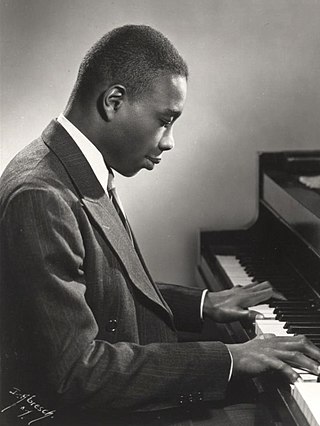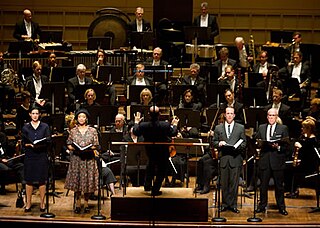Related Research Articles

Stuart Oliver Knussen was a British composer of contemporary classical music and conductor. Among the most influential British composers of his generation, his relatively few compositions are "rooted in 20th-century modernism, [but] beholden to no school but his own"

George Theophilus Walker was an American composer, pianist, and organist, and the first African American to win the Pulitzer Prize for Music, which he received for his work Lilacs in 1996. Walker was married to pianist and scholar Helen Walker-Hill between 1960 and 1975. Walker was the father of two sons, violinist and composer Gregory T.S. Walker and playwright Ian Walker.
Peter Adolf Serkin was an American classical pianist. He won the Grammy Award for Most Promising New Classical Recording Artist in 1966, and he performed globally, known for not only "technically pristine" playing but also a "commitment to contemporary music". He taught at the Curtis Institute of Music, the Juilliard School, Yale University, and Bard College.
Gordon Percival Septimus Jacob CBE was an English composer and teacher. He was a professor at the Royal College of Music in London from 1924 until his retirement in 1966, and published four books and many articles about music. As a composer he was prolific: the list of his works totals more than 700, mostly compositions of his own, but a substantial minority of orchestrations and arrangements of other composers' works. Those whose music he orchestrated range from William Byrd to Edward Elgar to Noël Coward.

Steven Edward Stucky was a Pulitzer Prize-winning American composer.
Václav Nelhýbel was a Czech-American composer, mainly of works for student performers.
Peter Goddard Lieberson was an American composer of contemporary classical music. His song cycles include two finalists for the Pulitzer Prize for Music: Rilke Songs and Neruda Songs; the latter won the 2008 Grawemeyer Award for Music Composition and both were written for his wife, the mezzo-soprano Lorraine Hunt Lieberson. His three piano concertos were each premiered by the pianist Peter Serkin, with the 1st and 3rd also being Pulitzer finalists.
Gary Alan Kulesha is a Canadian composer, pianist, conductor, and educator. Since 1995, he has been Composer Advisor to the Toronto Symphony Orchestra. He has been Composer-in-Residence with the Kitchener-Waterloo Symphony (1988–1992) and the Canadian Opera Company (1993–1995). He was awarded the National Arts Centre Orchestra Composer Award in 2002.
The Concerto Fantasy for Two Timpanists and Orchestra is a double timpani concerto written by Philip Glass in 2000. It is paired with the Cello Concerto on Vol. I of Glass' Concerto Project, a set of eight concerti by the composer. A typical performance of the work lasts 25–28 minutes. It was written for Jonathan Haas and later recorded by Evelyn Glennie, and was premiered by Haas and Svet Stoyanov with the American Symphony Orchestra in Avery Fisher Hall, Lincoln Center, conducted by Leon Botstein. The work was commissioned jointly by the American Symphony Orchestra, the Peabody Symphony, the Milwaukee Symphony, the St. Louis Symphony and the Phoenix Symphony. In 2004, a transcription for wind ensemble was written by Mark Lortz, which debuted at Peabody Institute in 2005.
The Piano Concerto is a concerto for solo piano and orchestra in three movements by the Finnish composer Esa-Pekka Salonen. The work was jointly commissioned by the New York Philharmonic, the BBC, the NDR Symphony Orchestra, and Radio France. It was premiered February 1, 2007 in Avery Fisher Hall, New York City, with Salonen conducting the pianist Yefim Bronfman and the New York Philharmonic. Salonen dedicated the piece to Yefim Bronfman.
Interventions is a composition for solo piano and orchestra by the American composer Elliott Carter. The work was composed at the behest of the pianist Daniel Barenboim and the conductor James Levine to celebrate Carter's 100th birthday. The piece was completed on April 16, 2007 and was first performed in Symphony Hall, Boston on December 4, 2008 by Daniel Barenboim and the Boston Symphony Orchestra under James Levine.
The Pied Piper Fantasy is a concerto for flute and orchestra by the American composer John Corigliano. The work was commissioned by the flutist James Galway and it is based on the tale of the Pied Piper of Hamelin. The piece was given its world premiere by Galway and the Los Angeles Philharmonic under the conductor Myung-whun Chung at the Dorothy Chandler Pavilion on February 4, 1982. In 1993, the critic Mark Swed of the Los Angeles Times described it as "one of the best known of modern American concertos."
The Piano Concerto No. 3 is a composition for solo piano and orchestra by the American composer Peter Lieberson. The work was commissioned by the Minnesota Orchestra for the ensemble's centennial. It was given its world premiere by the pianist Peter Serkin and the Minnesota Orchestra in Minneapolis on November 26, 2003. The piece is dedicated to Peter Serkin and was a finalist for the 2004 Pulitzer Prize for Music.
The Piano Concerto No. 1 is a composition for solo piano and orchestra by the American composer Peter Lieberson. The work was commissioned by the Boston Symphony Orchestra for its centennial. Lieberson started composing the piece in 1980 and completed it on March 2, 1983. It was written for the pianist Peter Serkin, who first performed the concerto with the Boston Symphony Orchestra under the direction of Seiji Ozawa on April 21, 1983. The piece is dedicated to Peter Serkin and Seiji Ozawa. It was a finalist for the 1984 Pulitzer Prize for Music.
The Viola Concerto is a composition for solo viola and orchestra by the American composer Peter Lieberson. The music was commissioned by the Toronto Symphony Orchestra and the Symphony Nova Scotia for Steven Dann, the principal violist of the Toronto Symphony. It was completed in 1992, though Lieberson later revised the work in 2003. The work is dedicated to Steven Dann.
Fresco is an orchestral composition by the Finnish composer Magnus Lindberg. The work was commissioned by the Los Angeles Philharmonic. Its world premiere was given in Los Angeles on March 12, 1998 by the Los Angeles Philharmonic under the direction of Esa-Pekka Salonen, to whom the piece is dedicated.
Sculpture is an orchestral composition by the Finnish composer Magnus Lindberg. The music was commissioned by the Los Angeles Philharmonic with support from the Koussevitzky Music Foundation to celebrate the orchestra's inaugural season at the Walt Disney Concert Hall. Its world premiere was given by the Los Angeles Philharmonic under the direction of Esa-Pekka Salonen on October 6, 2005.
Eros Piano is a piano concerto written by the American minimalist composer John Adams. The work was commissioned by the Koussevitzky Music Foundation in 1984 and was completed in 1989. Its world premiere was performed by the pianist Paul Crossley and the London Sinfonietta conducted by Adams on November 24, 1989, in Queen Elizabeth Hall, London. The piece is dedicated to Paul Crossley. It is the first of three piano concertos by Adams, followed by Century Rolls in 1996 and Must the Devil Have All the Good Tunes? in 2019.
Altar de Cuerda is a violin concerto written between September and December 2021 by the Mexican composer Gabriela Ortiz. The work was commissioned by the Los Angeles Philharmonic for the violinist María Dueñas, to whom the piece is dedicated. Its world premiere was given by María Dueñas and the Los Angeles Philharmonic conducted by Gustavo Dudamel at the Walt Disney Concert Hall on May 14, 2022. Altar de Cuerda is the seventh composition in Ortiz's Altares series, following Altar de Neón (1995), Altar de Muertos (1997), Altar de Piedra (2002), Altar de Fuego (2010), Altar de Luz (2013), and Altar de Viento (2015).
References
- 1 2 3 Lieberson, Peter (1999). "Red Garuda". G. Schirmer Inc. Retrieved June 1, 2016.
- ↑ Schweitzer, Vivien (July 29, 2010). "Sounds of a Composer Given Voice by His Muse". The New York Times . Retrieved June 1, 2016.
- ↑ Griffiths, Paul (July 25, 2000). "MUSIC REVIEW; The Challenge Of Living Up To a Past Coup". The New York Times . Retrieved June 1, 2016.
- ↑ Swed, Mark (December 9, 2000). "Eschenbach and 'Red Garuda' Soar". Los Angeles Times . Retrieved June 1, 2016.
- ↑ Clements, Andrew (3 June 2010). "Lieberson: Red Garuda; Rilke Songs; Piano Quintet, etc". The Guardian . Guardian Media Group . Retrieved June 1, 2016.